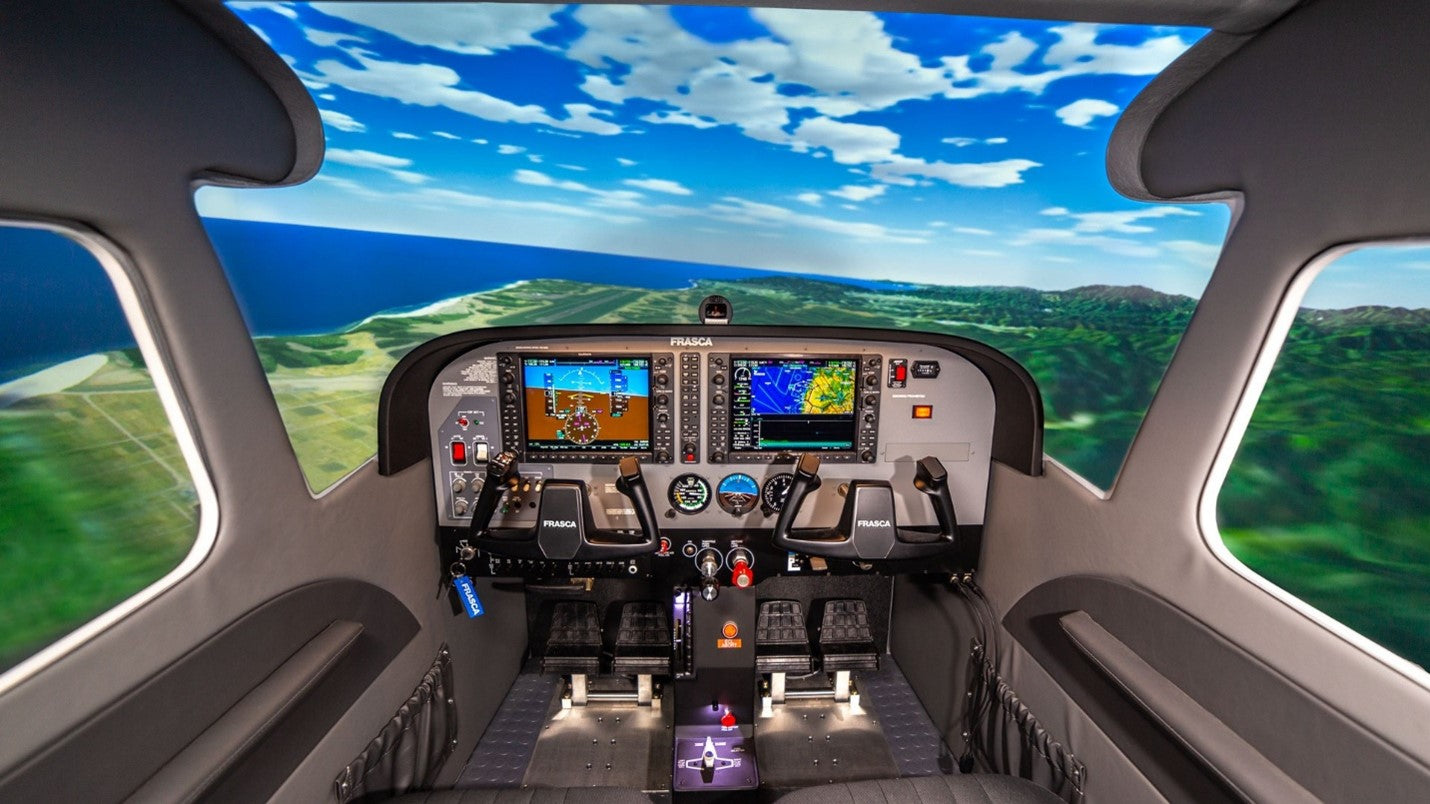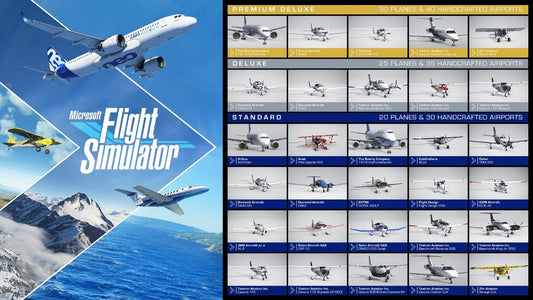The Role of Flight Simulators in Pilot Training

Not every aspiring pilot has the privilege of enrolling in a state-of-the-art, cutting-edge modern aviation facility equipped with all the technology needed for proper aviation training. This is where flight simulation comes in.
In today’s world, flight simulators have revolutionized the way pilots train. Higher-end models are able to precisely mimic real-life aircraft behavior down to the last minute detail. This lets pilots in training simulate their experience of flying the airplane without ever leaving the ground!
Research has shown that proper flight simulation accurately develops a pilot’s abilities from handling routine flight operations to properly addressing complex navigational tasks. As such, in this article, we will take a deep dive into the role of flight simulators in pilot training.
What Is a Flight Simulator?

A flight simulator is a device that allows a pilot to learn how to fly an aircraft by simulating all aspects of flying an aircraft without leaving the ground. It’s built to closely mimic the real-life controls, visuals, and even sounds of flying an actual airplane.
Common components of flight simulators include a mock cockpit, a flight control system, HD display screens, and sometimes a motion platform. In some situations, fully functioning avionics and instrument panels are also included but this is dependent upon the manufacturer of the flight simulator.
The way they work is pretty clever. Software inside the simulator creates a life-like virtual flying experience. For instance, the controls respond just like they would in a real aircraft, and the monitor screen shows everything from endless skies and simulated weather to buildings on the ground and even ocean waves, giving pilots a real sense of being in the air.
Flight simulators come in many forms. Budget-friendly options like the Redbird Jay are great for basic training. Mid-range setups such as the Elite Evolution S923 give more realistic features for deeper practice. At the higher end, Full Flight Simulators (FFS) like CAE 7000 Series or TRU Odyssey are used by airlines and professional training centers.
See? Owing to such remarkable capabilities, the role of a flight simulator in pilot training is nothing short of a marvel. Aviation authorities today actively require aviators to have spent time in flight simulators.
What Is a Good Flight Simulator Training Facility?

When it comes to pilot training, using a high-quality flight simulator is only part of the story. The role of flight simulators in pilot training goes way beyond using a flight simulator only. You must enroll in a dedicated aviation training centre where proper facilities are provided to become a certified pilot. Here’s what you need to consider.
Reputable flight simulator training facilities should comprise more than just new equipment. For instance, an ideal location would possess Full Flight Simulators (FFS), which simulate the actual flight experience of real aircraft. The configuration, such as the Airbus A320, a Boeing 737, or an ATR 600, will depend on what you plan to fly.
Another aspect involves the courses offered. An ideal flight simulator training facility will have proper courses catered to your present level of knowledge (from beginner to type rating) and compliant with international standards and guidelines by EASA (Europe), FAA (USA), and DGCA (India).
Yet, without teachers, even the best equipment means nothing. Therefore, an ideal flight simulator training facility will possess qualified instructors. The training staff must consist of well-trained and certified professionals with proper accreditation who not only have technical experience from flying but also the teaching ability to ensure the process goes as needed for you to become a qualified pilot.
Finally, a flight simulator training facility should have a reputation. The best training establishments are well-renowned throughout the industry and are go-tos for peer pilots.
To put it simply, the best flight simulator training facility has the newest technology, the best staff, and internationally certified training. This is the place where tomorrow's pilots are trained the right way and more importantly, the safe way.
How Flight Simulators Help You Become a Good Pilot

In the beginning stages, the role of flight simulators in pilot training is usually limited to basic flight controls—things like taking off, turning, landing, and using navigation instruments. Students can practice these skills without the pressure of being in the air, which helps reduce fear and allows room for mistakes. For example, trainees can repeat landings again and again, even in tough wind conditions, until they get it just right. This builds a strong foundation before they step into a real aircraft.
As you move forward, simulators help you train for more advanced tasks. For example, after you’ve completed basic training, you then start operating air traffic control, working with flight management systems and cockpit instruments, and managing communications.
One of the most important benefits of flight simulators is the ability to practice dangerous or rare situations safely. Think about Engine failures, electrical malfunctions, extreme storms, turbulence… all these events aren't typically replicated in a real training atmosphere. But in a flight simulator, students and pilots know how to maneuver through such situations without harming themselves or anyone else.
As aspiring aviator progress further in their training, they need to learn how to fly specific aircraft types for type rating certifications, where they must demonstrate deep knowledge of a particular aircraft. Full Flight Simulators (FFS) come in hand here. They allow pilots to get familiar with exact replica of systems, controls, and procedures of advanced planes like the Boeing 737 or Airbus A320 without actually flying them.
In addition to all the above-mentioned points, flight simulators are also used for Crew Resource Management (CRM) training. Unlike solo training where you train by yourself, the CRM programs require additional copilots to function as one in a cockpit to learn skills like communication, task division, and decision-making as one, like they would do in reality with a co-pilot and cabin crew.
Lastly, simulators are used for recurrent training. This is necessary because even when one becomes the best of the best, a pilot must always practice to avoid getting out of shape and to remain in peak condition. This is mandated to be done every few months. EASA, FAA, and DGCA require this to maintain a pilot's edge and to understand all of the new developments in safety regulations.
Benefits of a Flight Simulator Training

The role of flight simulators in pilot training has become indispensable, and for good reason. It offers a wide range of benefits that go far beyond just saving time or money. In fact, it’s one of the smartest and safest ways to build real-world flying experience without ever taking off.
Safety First
As glimpsed above, one of the biggest benefits of flight simulator training is safety. Simulators let you practice risky situations like engine failures, heavy turbulence, or emergency landings without any danger. You can make mistakes, learn from them, and try again—all in a completely risk-free environment. This kind of hands-on experience is hard to get anywhere else.
Cost-Effective Learning
Flying real aircraft is expensive. There are costs for fuel, aircraft rental, maintenance, and insurance. With simulators, those costs go down drastically. You can practice the same maneuvers while training for hours in a flight simulator all the while reducing your costs and still gaining valuable experience.
Train Anytime, Anywhere
Weather delays? Not a problem. Night flying? Easy. Simulators are available no matter the time of day or weather outside. They are not affected by outside conditions like weather or time of day. This means your training stays on schedule and can even move faster compared to traditional methods.
Faster Learning and Better Confidence
One of the coolest things about flight simulator training is that it’s way faster and effective. Instructors can repeat difficult lessons, adjust weather conditions, or simulate specific routes. As for students, they can learn and repeat procedures until they get them right. This helps build their confidence.
Practice for Real Situations
Simulators are designed to feel just like real aircraft. Modern flight simulators replicate almost everything from the inside of the cockpit to how the aircraft reacts in different situations. This gives pilots a true-to-life training experience where they can practice crosswind landings, radio calls, system failures, and more, just like how it would happen in real flight.
Certification-Ready
Regulatory bodies like EASA, FAA, and DGCA allow simulator hours to count toward official pilot training. This means you can complete parts of your required training through simulators and still meet international aviation standards.
To Wrap It Up

As seen above, the role of flight simulators in pilot training is very crucial. It offers the safest and most effective way for one to become a pilot. As technology continues to evolve, so will the procedures that pilots will adopt for their training. What do you think? Share your thoughts with us and let us know in the comments down below!





